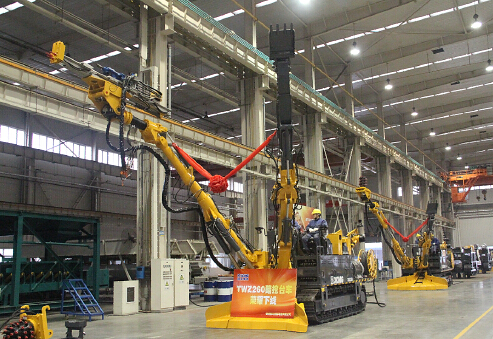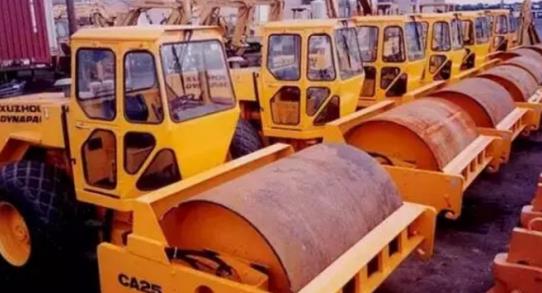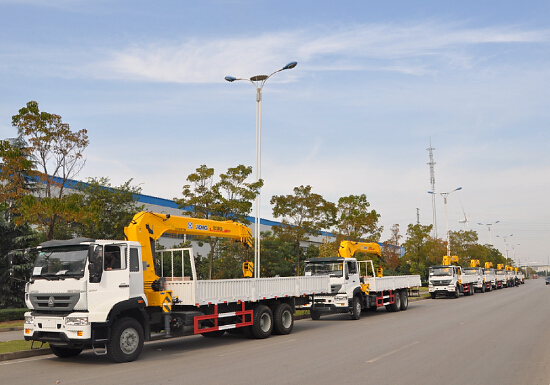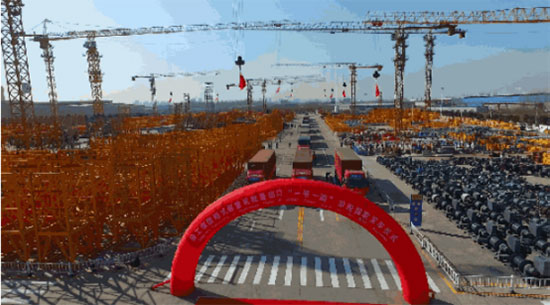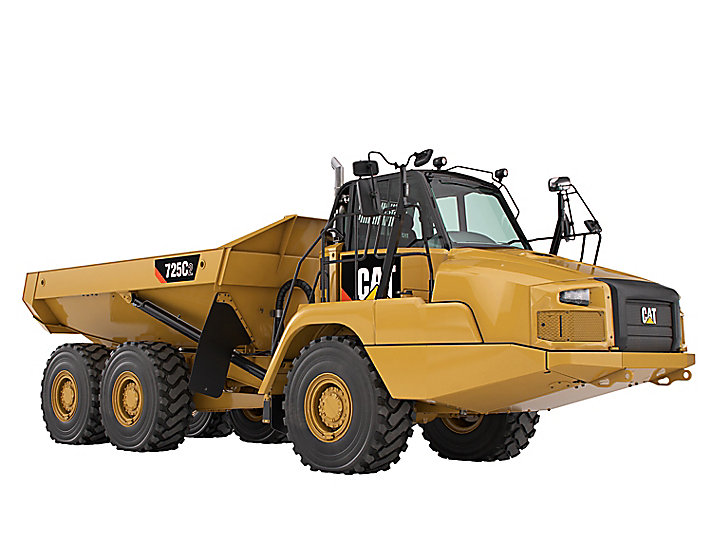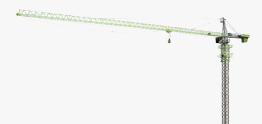

Contact information:
Terex Cranes Global Marketing
Press & Public Relations
E-mail: info.cranes@terex.com
Through the Roof: Terex® CC 2400-1 Lattice Boom Crawler Crane Takes Down Dismantled Overhead Cranes
SALZGITTER, September 17th, 2014 – Crane service provider Fricke-Schmidbauer Schwerlast GmbH used the compact Terex® CC 2400-1 lattice boom crawler crane to move two overhead cranes that had been removed from service at Salzgitter Flachstahl GmbH’s steel mill. There was no other option: No other crane with the required lifting capacity would have been able to perform the lifts at the extremely cramped facilities.
“The job was anything but usual: We had to bring the components of two dismantled ladle handling overhead cranes safely to the ground from a height of 38 meters (124.7 ft). These components weighed up to 105 tonnes (115.7 US t), and they had quite a history behind them, as they had been used to move 330 tonnes (363.8 US t) per piece of pig iron over a period of 40 years,” explains project manager Dirk Zocher. The biggest challenge turned out to be the way the mill was laid out: In between a maze of pipe bridges and cooling towers, there was an area of exactly 15 by 22 meters (49 by 72 ft) available for the crane to work on. And that was only after extensive preparations had been made: A train shed and several bumper blocks had to be removed first. And the freed-up space had to be leveled with track ballast due to the tracks running across it.
Meticulous Preparation
“All of it – including the lifts – had to be done quickly. We didn’t want to disrupt the mill’s rail traffic, and its production operations, any longer than we had to,” explains Zocher. Accordingly, the crane was delivered to the work site, before the lifts, using 20 trucks. After that, all the required components were set down, so that they would be ready to go, in a space behind the working area. The basic machine and the crawler tracks were assembled at this working area, after which the “skeleton” crane moved to its working spot, where Schmidbauer’s assembly technicians set it up for the lifts with the help of a Terex AC 100 all terrain crane. To ensure that the CC 2400-1 crane would be able to lift the loads, which weighed up to 105 tonnes (115.7 US t), at the required working radius of 34 meters (111.5 ft), it was set up with an SWSL configuration, a 36-meter (118 ft) main boom, and a 36-meter (118 ft) fly jib. In addition, the company used a 160-tonne (176.4 US t) Superlift counterweight and 160-tonnes (176.4 US t) of ballast on the basic unit. “This included a safety reserve of nine tonnes, as we wanted to make sure that we would be on the safe side at all times while working with the crane,” reports crane operator Enrico Spieß.
“Up Through the Roof”
In order to be able to take down the 400-tonne (440 US t) overhead cranes, they were first dismantled into “manageable parts” weighing 25 to 105 tonnes (27.5 to 115.7 US t). These individual components were then to be lifted through a 9 by 9 meter (29.5 ft²) opening in the mill’s roof. The problem: Only the smaller parts fit, and there was no way to get the larger components, which weighed anywhere from 76 to 105 tonnes (83.8 to 115.7 US t), through it. However, the Fricke-Schmidbauer team had a solution. The CC 2400-1 crane started by picking up the smaller components below the ceiling, lifting them through the opening, and then, after a 90° turn, loading them onto the heavy goods vehicles that were already waiting in front of the mill. And when it came to the heavy lifts, the crane picked up the components and, under the guidance of a signalperson, put them down on the floor inside the mill. Once they were there, the components were dismantled further so that they would be ready for transportation and were then loaded onto trucks. “We would have had to do this even if the opening in the roof had been bigger, since the limited space conditions would have made it impossible to swivel the CC 2400-1 crawler crane while using the suspended superlift counterweight required for the heaviest loads. In other words, the roof method would still only have worked for the smaller loads that didn’t require any suspended superlift counterweight,” explains Zocher.
Everything Goes According to Plan
This strategy enabled the Fricke-Schmidbauer team to fully move the two overhead cranes in a total of thirty lifts – ten for the heavier components and 20 for the lighter ones. This took the team a total of 15 days of 24-hour non-stop shift work, which was the only way to get the job done in time. “This was exactly the kind of project in which you have to be able to trust your machine, and the Terex CC 2400-1 lattice boom crawler crane delivered. On top of that, the complexity and tight schedule meant that if anything went wrong, we had to be sure that the manufacturer would take care of us quickly, which is also one of the reasons why we decided to use Terex for the job. And it was definitely the right decision,” Zocher happily summarizes.
About the Terex® CC 2400-1 lattice boom crawler crane
The Terex® CC 2400-1 lattice boom crawler crane has a maximum lifting capacity of 400 tonnes (440 US t)and a maximum load moment of 5168 tonne meter (323 t@16 m). Equipped with main boom, luffing jib and superlift the CC 2400-1 is one of the most powerful cranes in its class. With additional wind turbine erection equipment like the light fixed jib LF2 in 12, 24 or 36 m (39.3, 78.7, 118 ft) in combination with two reinforced boom sections the crane scopes with the majority of 1,5 to 2 MW wind turbines up to 130 m (426.5 ft) tower heights. For petrochemical and infrastructure we offer a variable superlift system which allows easy change of superlift radii. This gives customers the opportunity to reduce transport costs for counterweight. The superlift system can be combined with a telescope stinger system or a self propelled counterweight wagon.
About Fricke-Schmidbauer Schwerlast GmbH
“We move things – and we’ve done it for 145 years.” This is the slogan that has led Braunschweig-based Fricke-Schmidbauer Schwerlast GmbH to become an industry leader in the field of special load transportation and crane and assembly work. With a fleet of state-of-the-art heavy-goods vehicles and mobile cranes, the company provides customer-oriented solutions for a wide variety of needs not only in Germany, but also abroad.
Today, the business group employs 500 people and boasts more than 20 branch offices, 200 mobile cranes, and 150 heavy-goods vehicles.
About Terex
Terex Corporation is a diversified global manufacturer of a broad range of equipment that is focused on delivering reliable, customer-driven solutions for many applications, including the construction, infrastructure, quarrying, mining, shipping, transportation, refining, energy, utility and manufacturing industries. Terex reports in five business segments: Aerial Work Platforms; Construction; Cranes; Material Handling & Port Solutions; and Materials Processing. Terex offers financial products and services to assist in the acquisition of equipment through Terex Financial Services. More information can be found at www.terex.com.



